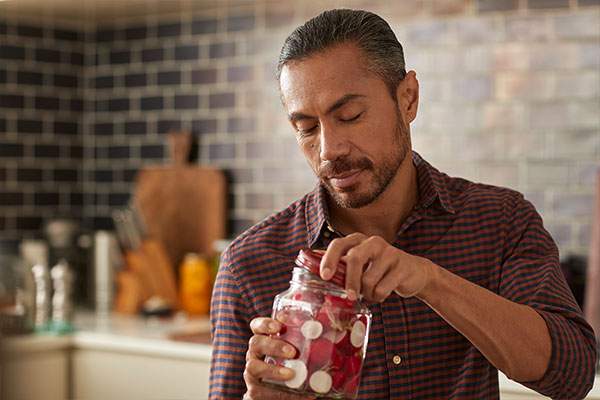-
When we talk about eating healthily, our thoughts tend to turn to leafy green vegetables and plump, vine-ripened tomatoes. We imagine the unmistakable crunch of a carrot, or the bright purple stain of a beetroot. Maybe the soft flesh of the world’s best avocado, squeezed over with lemon juice. Throw in some fresh herbs and a scattering of toasted pumpkin seeds for good measure. It’s the picture of health.
We don’t typically think about eating live bacteria.
Lucy Fitzgibbons does.
That’s because, as a naturopath, Lucy knows better than most that there are different ways of eating well and living better.
“The aim of the nutrition game is to eat a really varied diet,” she explains. “That’s because each food contains an array of different micronutrients and fibres which help to feed different bacterial strains in your gut. If you’re eating the same foods on repeat, you will only ever be feeding the same bacteria, and this will result in a microbiome lacking diversity.”
For Lucy, that diversity doesn’t always mean prepping the biggest bowl of salad imaginable. Sometimes it just means reaching for fermented foods.
Fermented foods for beginners
A quick science lesson: fermentation is the process by which microorganisms such as yeast and bacteria work to break down certain food components (such as glucose and sugar) into other products, like gases and organic acids. The result is a unique (and very tasty) food product, or fermented food, which contain healthy bacteria known as probiotics.
“Our microbiome (or gut flora) already consists of trillions of bacteria that we’ve been symbiotically living with since birth,” says science presenter and bestselling author Dr Michael Mosley. “We can manipulate our gut flora by consuming probiotics, taking certain medications and through our lifestyle choices. It’s important to try to foster a healthy microbiome as good health (including immunity) starts in the gut.”
So it’s in with the good and out with the bad, and it’s probably something you’ve eaten even if you didn’t realise it at the time. Kimchi, sauerkraut, sourdough, tempeh, miso, and cultured cheeses and yoghurts are all kinds of fermented food. As for beverages, you’ve got kombucha, beers, wines and ciders.
Introducing fermented foods into your diet doesn’t need to be complicated or time-consuming. In fact, humans have been fermenting foods for thousands of years, all over the world. Lucy encourages simplicity—whatever works for you and can be easily brought into your day-to-day meals.
“I like to keep things pretty simple,” she admits. “Just add a spoonful of sauerkraut to the side of your plate. You don’t always need to incorporate fermented foods into a recipe; you can simply add them as a condiment. Sauerkraut, kefir, miso and kombucha are readily available at supermarkets which makes it incredibly easy to keep them in rotation. Try a different one each week; remember, variation and consistency is key.”
Like when introducing anything new to your diet, remember to start slow. Especially when you’re dealing with live bacteria—even if it’s the healthy kind.
“Keep in mind, when adding extra fermented foods to your diet you may initially experience some gastrointestinal upset, like bloating or gas,” says Dr Mosley. “The fermented products produce gas in your digestive tract as they’re being digested and the assimilation of new microbes may also increase these effects.”
“Start small: a teaspoon of apple cider vinegar in water before meals, ¼ cup kombucha, 1 tablespoon of sauerkraut with a meal,” he encourages. “This will help your gut to recognise these foods in the future as you build up your tolerance and microbiome balance. By improving your gut health you’re improving your immune system and overall wellbeing.”
Getting started at home
If you’re itching to mix up your usual desk salad or your meat and two veg dinner, you can try your hand at fermenting at home. DIY fermentation isn’t costly, and it’s relatively easy to get started yourself. Once you get your hands on your preferred vegetables and spices, some salt and some sterilised jars, you’re almost ready to go.
“Fermenting at home is easier than it may look or sound,” Lucy assures. “Start with sauerkraut and make sure you use organic cabbage. Pesticides in conventional produce can kill off bacteria which are essential for the fermentation process.”
There are additional benefits of fermenting your own food, like cutting down on food waste and helping your gut to digest other foods more easily. Plus, the nature of fermented foods is that they’ll keep well, meaning you don’t need to rush to the bottom of the sauerkraut jar. Your breath will thank you later.
Medibank have partnered with Dr Michael Mosley and The Fast 800 to share tips for managing health and wellbeing. Dr. Michael Mosley is a world-renowned science presenter, journalist and author of best-selling books, including The Fast 800 and Clever Guts Diet. The Fast 800 program is an innovative approach to weight management, using the latest scientific research to support a healthy lifestyle. Talk to your GP before starting any new health program
Lucy Fitzgibbons is an online naturopath working out of Kingscliff.
Lifting the lid on fermented foods


Could this be living better?
What if living better didn't come with a guilt trip? See how real Aussies are living better and still doing what they love.